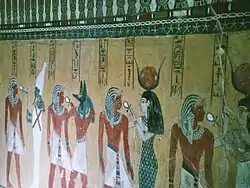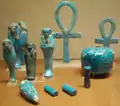KV43
Tomb KV43 is the tomb of Pharaoh Thutmose IV in the Valley of the Kings in Luxor, Egypt. It has a dog-leg shape, typical of the layout of early 18th Dynasty tombs. KV43 was rediscovered in 1903 by Howard Carter on behalf of Theodore M. Davis.[1]
| KV43 | |||
|---|---|---|---|
| Burial site of Thutmose IV | |||
 | |||
 KV43 | |||
| Coordinates | 25°44′19.2″N 32°36′11.1″E | ||
| Location | East Valley of the Kings | ||
| Discovered | 1903 | ||
| Excavated by | Howard Carter | ||
Discovery and location

This tomb was discovered by Howard Carter in January 1903 as part of the systematic clearance of a small valley that runs west from the tomb of Ramesses III (KV3). These excavations were conducted by the Antiquities Service on behalf of Theodore Davis. An alabaster vase inscribed with the name of Thutmose IV had been encountered part way up the valley in 1902, leading Carter to suspect he was close to the tomb. By January 1903, investigations reached the base of a sheer cliff; here the bedrock rises to form a natural platform which was leveled to take the tomb cutting. On this platform, in front of the tomb entrance, two intact foundation deposits were uncovered containing alabaster vessels and model implements; one of them, an alabaster saucer, had been usurped from Hatshepsut. The discovery of these items, along with others also bearing the king's name, confirmed this was the tomb of Thutmose IV. On 18 January 1903 the entrance was cleared enough to permit an exploration; Davis had already left for Aswan, and Carter, unable to contact him, resolved to enter the tomb anyway, inviting American amateur Egyptologist Robb de Peyster Tytus along for the inspection.[1]
Layout

A – Entrance
B – Corridor
C – Steps
D – Corridor
E – Well shaft
F – First pillared hall
G – Steep corridor
H – Steps
I – Antechamber
J – Burial chamber
Ja–Jd – Storerooms
The tomb follows on from the design and layout of KV35 but is more precise in its cutting and alignment. The first three corridors end in a deep well with a chamber at the bottom. The axis then turns 90 degrees with the first pillared hall which leads, with stairs and a sloping corridor, to the antechamber and burial chamber. In a departure from KV35, the far end of the burial chamber is lowered to form a "crypt" for the sarcophagus. An innovative feature of this tomb is the presence of magical niches, which are seen in all later 18th Dynasty and early 19th Dynasty tombs. Four storerooms are arranged symmetrically on either side of the burial chamber.[2]
Investigation and contents
The tomb had been thoroughly robbed in antiquity, and Carter found the entrance passage partly filled with debris and broken artefacts. The blocked and painted doorway leading to the first pillared hall had been penetrated by robbers. More tangible evidence of their presence was encountered in the hall: a rope made of palm fiber was still secured around one of the columns, with its end reaching the bottom of the well shaft. Evidence of double-sealing was encountered in the antechamber; seals bearing the name of Horemheb occurred in addition to the original 'jackal over captives' necropolis seal on a partially blocked doorway.[1]
The pharaoh's red stone sarcophagus, covered in yellow-filled text and figures, was still in place in the burial chamber. Its lid was propped up beside it, supported by slabs of stone and the sculpted wooden head of cow. The sarcophagus and lid have a rounded head end and a square foot end. Nephthys, with arms raised, is on the head end, while Isis, in the same attitude, is at the feet. The sides depict the king with Anubis, accompanied by text. The sarcophagus contained two wooden figures[1] - the king's mummy had been found five years earlier among the royal mummies cached in KV35.[3]
The burial chamber also contained the body of a chariot decorated with scenes of the king slaying enemies, an archer's gauntlet made of red and green leather, parts of a tapestry-woven garment with the name of Amenhotep II, bitumen-coated statuettes of the king, fragments of stone vases, broken fan handles, and portions of a cedar wood throne.[1]
Inspection of the side chambers yielded varying results: Chamber Ja (see plan) only contained the a mass of linen wrappings from a mummy; Chamber Jb contained victual mummies of meat and birds; Chamber Jc contained broken jars and large quantities of grain; Chamber Jd contained masses of broken faience vessels and shabti, along with the unwrapped mummy of a young boy propped up against the wall. This boy is likely Prince Amenemhat, whose canopic jars were found in the tomb. Canopic jars of a Princess Tentamun were also found, indicating that she was once interred in her father's tomb. No trace of blocking or sealing was found at the entrances of these chambers so they were likely closed with wooden doors, long since looted, as evidenced by sockets, and a wooden lintel on Chamber Ja.[1]
Decoration
Only two rooms in this tomb were decorated: the upper part of the well shaft, and the antechamber. The ceilings of both areas are decorated with yellow stars on a blue background. In the case of the well, only two walls are fully decorated: they begin with a kheker-frieze and the left wall depicts Thutmose before Osiris, Anubis, and Hathor. The other wall is unfinished and depicts Anubis. In the antechamber likewise only two walls are painted and have the same repeating decorative scheme of the king depicted before various gods.[1]
Graffiti

Two hieratic inscriptions are written in black on the right-hand wall of the antechamber. Both relate to an inspection of the tomb in the reign of Horemheb by officials.[1] The first, larger inscription is as follows:
Year 8, 3rd month of akhet-season, day 1, under the majesty of the King of Upper and Lower Egypt, Djeserkheperure-setepenre, son of Re Horemheb-merenamun. His majesty life! prosperity! health! commanded that the fan-bearer on the king's right hand, the king's scribe, overseer of the treasury, overseer of works in the Place of Eternity [i.e. the royal necropolis] and leader of the festival of Amun in Karnak, Maya, son of the noble Iawy, born of the lady of the house Weret, be charged to renew the burial of King Menkheperure, true of voice, in the noble mansion upon the west of Thebes.[2]
The second inscription, to the right and slightly higher than the large one, is much shorter:
His assistant, the steward of the southern city, Djehutymose, whose mother is Iniuhe of the city [i.e. Thebes].[2]
The larger inscription refers to Maya in the second person, and incorrectly names his mother as Weret, making it unlikely that he was the author of the inscription. The handwriting of the two graffiti are identical, and it is known that the restoration of Tutankhamun's tomb was also carried out by Djehutymose as he left a graffito there too. Therefore, Maya likely delegated the task of inspecting and restoring the tomb to his subordinate, Djehutymose.[4]
Gallery
 Arm panel from a ceremonial chair of Thutmose IV depicting the king as a sphinx trampling enemies, now in the Metropolitan Museum
Arm panel from a ceremonial chair of Thutmose IV depicting the king as a sphinx trampling enemies, now in the Metropolitan Museum Arm panel from a ceremonial chair of Thutmose IV depicting the king seated with Thoth and a lioness-headed goddess, now in the Metropolitan Museum
Arm panel from a ceremonial chair of Thutmose IV depicting the king seated with Thoth and a lioness-headed goddess, now in the Metropolitan Museum Faience shabti and assorted faience amulets, now in the Metropolitan Museum
Faience shabti and assorted faience amulets, now in the Metropolitan Museum A hes-vase now in the Metropolitan Museum
A hes-vase now in the Metropolitan Museum The sarcophagus in the burial chamber
The sarcophagus in the burial chamber
References
- Carter, Howard; Newberry, Percy E. (1904). The Tomb of Thoutmôsis IV. Westminster: Constable. Repr. London: Duckworth, 2002. ISBN 0-7156-3120-9.
- Reeves, Nicholas; Wilkinson, Richard H. (2010). The Complete Valley of the Kings : Tombs and Treasures of Egypt's Greatest Pharaohs (Paperback reprint ed.). London: Thames and Hudson. pp. 105–108. ISBN 978-0-500-28403-2.
- Loret, Victor (1898). "Le tombeau d'Aménophis II et la cachette royale de Biban el-Molouk". Bulletin de l'Institut Égyptien. 9: 98–112. Retrieved 20 July 2020.
- Cross, Stephen (2008). "The Restoration Graffiti in the Tomb of Tuthmosis IV, KV43" (PDF). The Heritage of Egypt. 1, Number 3 (3): 9–11. Retrieved 5 August 2020.
External links
| Wikimedia Commons has media related to KV43. |
- Theban Mapping Project: KV43 - Includes detailed maps of the tomb.
